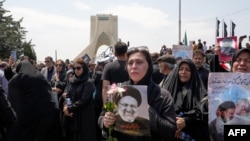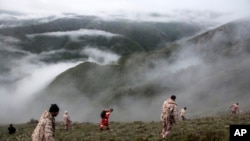Iran and Russia have seized on the May 19 helicopter crash that killed Iranian President Ebrahim Raisi and Foreign Minister Hossein Amir-Abdollahian to attack U.S. sanctions while implicating Washington in their deaths.
Tehran and Moscow are dealing with heavy diplomatic and economic restrictions the U.S. and allies imposed to curb the authoritarian regimes’ ability to sustain aggressive domestic and foreign policies. Iran and Russia claim the sanctions only serve to boost their economies and world stance, but their reaction to Raisi incident contradict the traditional bravado.
Iran’s former foreign minister Javad Zarif set the tone on May 20, claiming that “One of the culprits behind yesterday’s tragedy is the United States, because of its sanctions that bar Iran from procuring essential aviation parts.”
In Moscow, Russian Foreign Minister Sergey Lavrov echoed: "The Americans disown this, but the truth is that other countries against which the United States announced sanctions do not receive spare parts for American equipment, including aviation."
CNN's diplomatic editor Nic Robertson dissected and dismissed Zarif’s allegations as “tainted by hubris.”
“If, as he claims, the president’s helicopter were victim to a paucity of quality spare parts due to U.S. sanctions, why risk the life of the president and the foreign minister in an aircraft considered potentially unreliable,” Robertson wrote in a May 21 analysis.
In China, no high-ranking official voiced support for Iran’s accusations against the U.S., although VOA’s Mandarin service documented how Chinese state-aligned media and social media users have savored on the potential role U.S. sanctions played in the fatal helicopter crash.
Others in China and beyond speculated that Israel may have been behind the incident.
Western social media erupted with memes, GIFs, and songs praising Raisi’s pilot by the name of “Eli Copter” (Read: helicopter) an agent of Israeli intelligence service Mossad.
New accounts emerged under the same name instantly getting hundreds of followers.
One account, called the Associated Fress, joined the trend with a so-called “news report” about the Israeli intelligence mourning the loss of its agent Eli Copter.
But some mistook the joke for a breaking news story and shared it as such, including pro-Hamas Telegram channels.
Russia’s chief propagandist Vladimir Solovyov showed millions of his viewers a fragment of France 24 satirical clip featuring Eli Copter, which he presented as an actual news report, to then accuse Israel of “political murder.”
Ghassan Ben Jeddou, the chairman of the Board of Directors of the Lebanon-based pro-Hezbollah Al Mayadeen Media Network, downplayed suggestions of foul play.
“It seems in high probability that the accident occurred naturally,” he said, adding that the death of Iranian president was bound to generate “some speculation.”
It is no secret that Iran’s aircraft fleet is well-worn.
“Iran’s aviation industry has been blighted by years of neglect, underinvestment, and grueling sanctions that have made it nearly impossible to purchase new aircraft,” Iranian-born journalist Kourosh Ziabari wrote in March 2023.
But the state of Iran’s aviation industry and the decision for Raisi to travel by helicopter that day in foggy weather with poor visibility over mountainous terrain are separate issues.
CNN’s Robinson questioned why the same advanced technology Iran uses for military purposes was not deployed to ensure the helicopter’s safety.
“For a nation that makes, uses, and exports long-range killer drones to countries like Russia for its war in Ukraine, and non-state actors like Iraqi militia and Yemen’s Houthis – who are currently holding global maritime trade to ransom targeting ships in the Red Sea – they didn’t appear to have a simple surveillance drone capable of the job.”
The Associated Press said Iran’s abysmal air safety record extends beyond U.S. aircraft and has impacted other officials.
The AP reported that former Iranian presidents Mahmoud Ahmadinejad and Abolhasan Banisadr both survived helicopter crashes while in office.
Patrick Clawson, a Research Counselor at The Washington Institute, told the London-based broadcaster Iran International, which is critical of the Islamic Republic, Iran has suffered 20 deadly airline crashes since 2000, killing more than 1,700 people.
Only eight of those aircraft were U.S. made.
"20 crashes ...give me a break, folks. Your aircraft safety record is just dreadful," Clawson said.
His statistic does not include Iran’s accidental downing of Ukraine International Airlines Flight 752 in January 2020, a crash that killed all 176 people on board.
“Iran’s air fleet is a metaphor for the regime as a whole,” Ali Ansari, founder of the Institute of Iranian Studies at the University of St Andrews, told the Financial Times. “It’s old, should not be able to keep flying, and yet does — until it doesn’t.”
Since the 1979 seizure of the U.S. Embassy in Tehran, the U.S. has imposed a series of sanctions on Iran, including on its aviation industry.
A 2019 U.S. Department of the Treasury advisory said Iran uses commercial airlines “to foment regional violence through terrorism, its weapons programs, and other destabilizing activity.”
This includes delivering arms to “Axis of Resistance” allies like the Lebanese militant group Hezbollah, and the Houthis in Yemen, as well as the regime of Syrian President Bashar al-Assad.
Tehran has also used civilian airliners to provide Moscow weapons to wage its war against Ukraine, and help Russia circumvent extensive sanctions, including on its own aviation industry.














